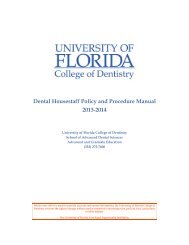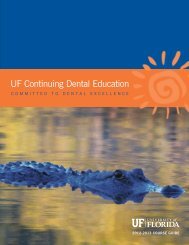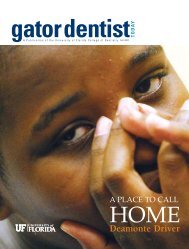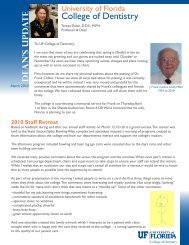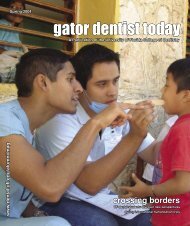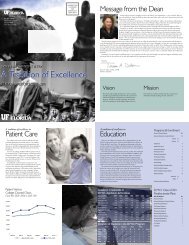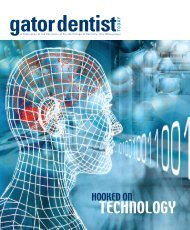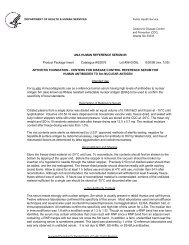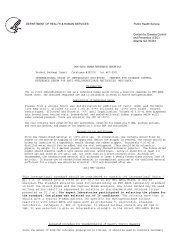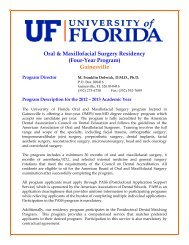gator dentist today - College of Dentistry - University of Florida
gator dentist today - College of Dentistry - University of Florida
gator dentist today - College of Dentistry - University of Florida
Create successful ePaper yourself
Turn your PDF publications into a flip-book with our unique Google optimized e-Paper software.
This introspective process will demand the college make<br />
some hard decisions about where future investments in research<br />
should be made. So far, everyone seems to agree that clinical<br />
translational research would enable greater alignment with<br />
National Institute <strong>of</strong> Dental and Crani<strong>of</strong>acial Research goals<br />
<strong>of</strong> continuing the “struggle” against two <strong>of</strong> the most common<br />
infectious diseases — dental caries and periodontal diseases<br />
— and the elimination <strong>of</strong> oral and pharyngeal malignancies,<br />
crani<strong>of</strong>acial birth defects and developmental disorders, acute<br />
and chronic or<strong>of</strong>acial pain, and other conditions that threaten<br />
oral health.<br />
“Clinical translational research and periodontal<br />
research are areas in which we are not as strong as some other<br />
institutions, but there’s a good foundation in place here on<br />
which to build,” Burne said.<br />
That foundation includes the college’s broad patient<br />
base to support both areas <strong>of</strong> research. Burne believes a<br />
few key recruitments <strong>of</strong> faculty to write the program<br />
grants and do the research would be a big step in<br />
the right direction.<br />
Burne said another <strong>of</strong> the college’s<br />
greatest strengths is its ability to establish<br />
collaborative relationships with multidisciplinary<br />
researchers at the health center. “I<br />
think it’s easy to recruit people to <strong>Florida</strong> when<br />
you recruit in areas where people can see immediate<br />
linkages,” Burne said. “For instance, there are a<br />
lot <strong>of</strong> logical applications in <strong>dentist</strong>ry for areas like<br />
biomemetics (tissue engineering), involving<br />
everything from implants to stem cell biology. We<br />
have a great stem cell group conducting research<br />
in the Health Science Center and a brand new<br />
biomedical engineering program.”<br />
Building on Success<br />
Collaborative efforts among dental<br />
scientists and researchers in other areas <strong>of</strong> the<br />
Health Science Center have already proven<br />
fruitful. Several important patents have resulted from these<br />
research partnerships, including a technology called IVIAT,<br />
which identifies proteins expressed by disease-causing bacteria<br />
during the infection process. IVIAT was initially developed<br />
to study infections <strong>of</strong> Actinobacillus actinomycetemcomitans in<br />
juvenile periodontitis patients. It is also licensed to researchers<br />
outside the university for use in the study <strong>of</strong> a wider array <strong>of</strong><br />
viral, fungal, parasitic and other bacterial infections, including<br />
that <strong>of</strong> Pseudomonas aeruginosa in cystic fibrosis patients.<br />
The department <strong>of</strong> oral biology’s Center for Molecular<br />
Microbiology supports collaboration among infectious disease<br />
researchers and clinicians from the colleges <strong>of</strong> <strong>Dentistry</strong>,<br />
Medicine and Veterinary Medicine. The focus <strong>of</strong> the center is to<br />
explore the mechanisms <strong>of</strong> microbial pathogenesis and invent<br />
novel technologies for the discovery <strong>of</strong> new antimicrobial<br />
targets, vaccines and diagnostics.<br />
One <strong>of</strong> the Center for Molecular Microbiology’s<br />
exciting developments is the recently patented technology for<br />
the treatment <strong>of</strong> malignant tumors, based on the findings <strong>of</strong> UF<br />
dental researchers Ann Progulske-Fox, Ph.D., and Emil Kozarov,<br />
“I think this college<br />
is extremely strong<br />
in basic science<br />
research.... Yet there<br />
is a tremendous<br />
amount <strong>of</strong> untapped<br />
potential....”<br />
Ph.D. They discovered that enzymes produced by the oral<br />
bacterium Porphyromonas gingivalis have the ability to degrade<br />
the bonds that hold certain types <strong>of</strong> human cells together.<br />
The patented technology using the enzyme can be applied<br />
to selectively destroy newly formed blood vessels that feed<br />
tumors, while at the same time loosening the cellular structure<br />
<strong>of</strong> the tumor to allow greater access for current therapeutics.<br />
They also are investigating the potential <strong>of</strong> applying the<br />
technology to other diseases that require the growth <strong>of</strong> new<br />
blood vessels, such as macular degeneration, psoriasis and<br />
rheumatoid arthritis.<br />
Other research partnerships exist between the college<br />
faculty and researchers at the university’s McKnight Brain<br />
Institute, medicine’s department <strong>of</strong> rheumotology, the Center<br />
for Orphaned Autoimmune Disorders, and the Shands Hospital<br />
Cancer Center.<br />
Another strength <strong>of</strong> the college’s research is its<br />
diversity and quality. State-<strong>of</strong>-the-art techniques<br />
are used to study the molecular genetics and<br />
physiology <strong>of</strong> bacterial pathogenesis; the<br />
physiology, pharmacology and genetics<br />
<strong>of</strong> exocrine secretion; basic function and<br />
modulation <strong>of</strong> the mucosal immune system;<br />
autoimmunity; and the interaction <strong>of</strong> pathogenic<br />
organisms with host cells.<br />
Burne predicts the research infrastructure<br />
planning assessment will also identify molecular and<br />
cellular immunology as areas in need <strong>of</strong> recruitment,<br />
but he defers final judgment to the internal and<br />
external advisory committees that will be formed<br />
as part <strong>of</strong> the assessment.<br />
“The internal and external advisory<br />
committees are going to have a lot <strong>of</strong> work to<br />
do. But one <strong>of</strong> the things that surprised me was<br />
that, when you tally up all <strong>of</strong> the numbers, early<br />
feedback is not out <strong>of</strong> proportion to what is<br />
realistic,” Burne said.<br />
It is very realistic to expect the college<br />
will continue its expansion <strong>of</strong> research activities,<br />
building on the synergy created by collaborations with other<br />
Health Science Center researchers and the scientific community’s<br />
growing arsenal <strong>of</strong> hi-tech tools. These research efforts will lead<br />
to improved clinical treatments for a broad spectrum <strong>of</strong> patient<br />
maladies in both <strong>dentist</strong>ry<br />
and medicine.<br />
“We have been<br />
successful largely because<br />
<strong>of</strong> a small number <strong>of</strong> highly<br />
productive people. We now<br />
have a golden opportunity<br />
to go to the next level<br />
and become the type <strong>of</strong><br />
institution that is conducting<br />
state-<strong>of</strong>-the-art research <strong>of</strong><br />
the type that the National<br />
Institute <strong>of</strong> Dental and<br />
Crani<strong>of</strong>acial Research wants<br />
done in dental schools,”<br />
Burne said.<br />
Photo - Lindy Brounley<br />
Gator Dentist Today Fall/Winter 2003 11



